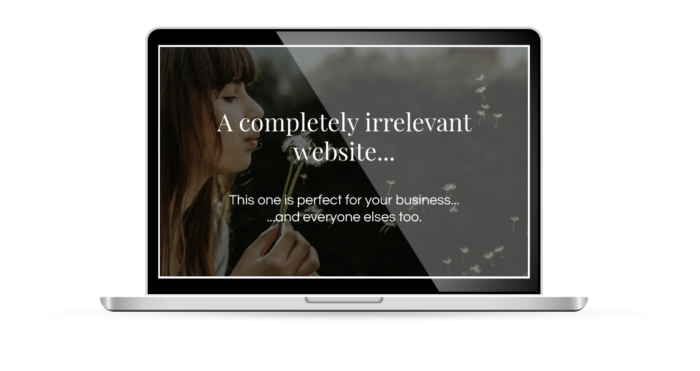Self-building using a template website can sound like a great idea, but before you start there are just a few things we need to talk about.
Building your own website seems like a really cheap way to get your business online. You are not bound by any contracts with web developers, nor are you faced with huge bills for web design. You have no third party to contend with when you need small updates and you feel like you can just get stuck in and do it all yourself. No charges, no problem.
After all, the countless celebrity endorsed adverts on telly suggest anyone can do it. Even Keanu Reaves built his own website. And if Freddie Flintoff can do it, ‘so can I,’ you say.
You have started the ball rolling, and already you feel like Bill Gates. Your domain name is purchased and you are already looking through website templates. You are met with clichés such as ‘…uniting beauty and the power of technology to create your stunning website…’ and ‘make it yours. Make it beautiful.’
Move over Tim Berners-Lee, I’m about to revolutionise the internet…
We know the feeling. We do it every single day. We understand that a new website signals a new phase of your business. It represents business growth and opportunity. Your new website should be treated like a precious jewel which will only increase in value as it makes you more money.
If you know exactly what you are doing, then go right ahead and start building. We do, however want to you continue reading and help you understand the complexities and needs of a fully-functioning, user friendly website that is fully optimised for growth and marketing.
A website should be treated as a living, breathing entity that needs love and attention.
Design
The first thing to understand when choosing a website template is that the design has been created for, purely and simply, a design concept. The stock images you see, the fonts, the text placement and the layout have all been chosen without much thought other than to make a site that looks fit for purpose.
And the template’s purpose is to be a template. Nothing more, nothing less.
It is not a template suited for your business. It is an empty shell with no relative meaning. It uses stock images that come from a bank of commercial photography. Stock photos have their place in the commercial world, but remember they have been chosen purely to draw you in to the website template and think “this looks beautiful. I want this website.”
Design templates lure you in to a false sense of depth and integrity.
 When I design a website for a client, my first move is to visit the client, take a tour and talk to them. I want to understand their personality and the brand. Every brand has a unique “personality” too and I want it to hit the user in the face as soon as they land on the website. Templates don’t do that. They don’t understand how you tick or the audience you are trying to convert.
When I design a website for a client, my first move is to visit the client, take a tour and talk to them. I want to understand their personality and the brand. Every brand has a unique “personality” too and I want it to hit the user in the face as soon as they land on the website. Templates don’t do that. They don’t understand how you tick or the audience you are trying to convert.
Marketing
We have taken on a lot of clients recently who built their own website and can’t understand why it isn’t performing for them. Crucially, most clients don’t have the time to fully manage the marketing capability of their site, from SEO to link building, digital advertising etc.
‘Why am I not getting visitors?’
‘I can’t understand why I’ve had no enquiries through the site’
‘I don’t appear on Google.’
One client even went so far as to say ‘I don’t get anything through the site so I don’t think I really need it.’
Marketing a website takes a lot of time and technical and search engine knowledge. SEO, social media, pay per click, traffic, audience behaviour and analytics all need to be considered to drive traffic and conversions once you have the sales funnel nailed. Do you have the time to manage all this at the same time as running a business?
Technical issues
Building your own site to save costs can work perfect for anyone if they know what they’re doing… until something goes wrong.
Consider where your website is hosted. It will be sat on a server, in a server farm somewhere in the UK. The server will be managed by your ‘host’ who has access to your site through the server, whose job it is to make sure it’s always working and secure.
When something goes wrong with your site, sometimes the problem can be at server level, meaning it has to be solved by the server ‘host.’ When your site is hosted by the internet companies such as 1&1 or GoDaddy, you rely on a third party that may not be able to solve the issue as fast as you need.
Your beloved website is completely out of your hands.
Never rule out using a small, local web company to host your site, knowing that they have immediate access should anything go wrong. Research your local web development companies and gauge how trustworthy they are. They may have a portfolio of well-designed websites, but how good are they technically? Do they host their client’s sites? How quick do they solve problems?
The best way to gauge how a web designer or web agency works is to contact a couple of their current clients and ask them. There is no shame in doing a bit of digging.
We host all our client sites at competitive rates, with every site holding an SSL certificate. If something goes wrong, we make it our priority to get your site back up and running, because we understand as a small independent business how valuable your site is.
So now what?
Do your research and look at every possibility – and set a budget for development, design and marketing. If you are unsure of how much a website is going to cost, then spend some time getting quotes from local, trusted website agencies. If self-building is your only option, make sure you are ready for any pitfalls and have contacts of people you may need help from.
A word of warning – if it all goes horribly wrong, you may have to pay more money to solve the problems. You know the phrase, if you buy cheap, you buy twice.
We would be more than happy to chat through all your options. We know ever business is different so arrange a no-obligation consultation with us to find out more.




